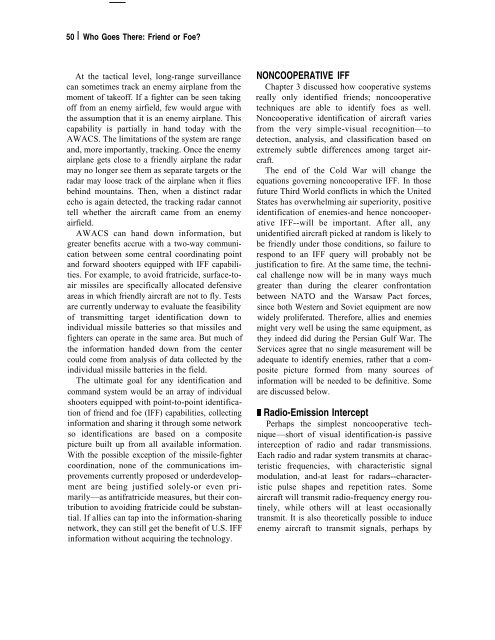Who Goes There: Friend or Foe? - Federation of American Scientists
Who Goes There: Friend or Foe? - Federation of American Scientists
Who Goes There: Friend or Foe? - Federation of American Scientists
You also want an ePaper? Increase the reach of your titles
YUMPU automatically turns print PDFs into web optimized ePapers that Google loves.
50 I <strong>Who</strong> <strong>Goes</strong> <strong>There</strong>: <strong>Friend</strong> <strong>or</strong> <strong>Foe</strong>?<br />
At the tactical level, long-range surveillance<br />
can sometimes track an enemy airplane from the<br />
moment <strong>of</strong> take<strong>of</strong>f. If a fighter can be seen taking<br />
<strong>of</strong>f from an enemy airfield, few would argue with<br />
the assumption that it is an enemy airplane. This<br />
capability is partially in hand today with the<br />
AWACS. The limitations <strong>of</strong> the system are range<br />
and, m<strong>or</strong>e imp<strong>or</strong>tantly, tracking. Once the enemy<br />
airplane gets close to a friendly airplane the radar<br />
may no longer see them as separate targets <strong>or</strong> the<br />
radar may loose track <strong>of</strong> the airplane when it flies<br />
behind mountains. Then, when a distinct radar<br />
echo is again detected, the tracking radar cannot<br />
tell whether the aircraft came from an enemy<br />
airfield.<br />
AWACS can hand down inf<strong>or</strong>mation, but<br />
greater benefits accrue with a two-way communication<br />
between some central co<strong>or</strong>dinating point<br />
and f<strong>or</strong>ward shooters equipped with IFF capabilities.<br />
F<strong>or</strong> example, to avoid fratricide, surface-toair<br />
missiles are specifically allocated defensive<br />
areas in which friendly aircraft are not to fly. Tests<br />
are currently underway to evaluate the feasibility<br />
<strong>of</strong> transmitting target identification down to<br />
individual missile batteries so that missiles and<br />
fighters can operate in the same area. But much <strong>of</strong><br />
the inf<strong>or</strong>mation handed down from the center<br />
could come from analysis <strong>of</strong> data collected by the<br />
individual missile batteries in the field.<br />
The ultimate goal f<strong>or</strong> any identification and<br />
command system would be an array <strong>of</strong> individual<br />
shooters equipped with point-to-point identification<br />
<strong>of</strong> friend and foe (IFF) capabilities, collecting<br />
inf<strong>or</strong>mation and sharing it through some netw<strong>or</strong>k<br />
so identifications are based on a composite<br />
picture built up from all available inf<strong>or</strong>mation.<br />
With the possible exception <strong>of</strong> the missile-fighter<br />
co<strong>or</strong>dination, none <strong>of</strong> the communications improvements<br />
currently proposed <strong>or</strong> underdevelopment<br />
are being justified solely-<strong>or</strong> even primarily—as<br />
antifratricide measures, but their contribution<br />
to avoiding fratricide could be substantial.<br />
If allies can tap into the inf<strong>or</strong>mation-sharing<br />
netw<strong>or</strong>k, they can still get the benefit <strong>of</strong> U.S. IFF<br />
inf<strong>or</strong>mation without acquiring the technology.<br />
NONCOOPERATIVE IFF<br />
Chapter 3 discussed how cooperative systems<br />
really only identified friends; noncooperative<br />
techniques are able to identify foes as well.<br />
Noncooperative identification <strong>of</strong> aircraft varies<br />
from the very simple-visual recognition—to<br />
detection, analysis, and classification based on<br />
extremely subtle differences among target aircraft.<br />
The end <strong>of</strong> the Cold War will change the<br />
equations governing noncooperative IFF. In those<br />
future Third W<strong>or</strong>ld conflicts in which the United<br />
States has overwhelming air superi<strong>or</strong>ity, positive<br />
identification <strong>of</strong> enemies-and hence noncooperative<br />
IFF--will be imp<strong>or</strong>tant. After all, any<br />
unidentified aircraft picked at random is likely to<br />
be friendly under those conditions, so failure to<br />
respond to an IFF query will probably not be<br />
justification to fire. At the same time, the technical<br />
challenge now will be in many ways much<br />
greater than during the clearer confrontation<br />
between NATO and the Warsaw Pact f<strong>or</strong>ces,<br />
since both Western and Soviet equipment are now<br />
widely proliferated. <strong>There</strong>f<strong>or</strong>e, allies and enemies<br />
might very well be using the same equipment, as<br />
they indeed did during the Persian Gulf War. The<br />
Services agree that no single measurement will be<br />
adequate to identify enemies, rather that a composite<br />
picture f<strong>or</strong>med from many sources <strong>of</strong><br />
inf<strong>or</strong>mation will be needed to be definitive. Some<br />
are discussed below.<br />
1 Radio-Emission Intercept<br />
Perhaps the simplest noncooperative technique—sh<strong>or</strong>t<br />
<strong>of</strong> visual identification-is passive<br />
interception <strong>of</strong> radio and radar transmissions.<br />
Each radio and radar system transmits at characteristic<br />
frequencies, with characteristic signal<br />
modulation, and-at least f<strong>or</strong> radars--characteristic<br />
pulse shapes and repetition rates. Some<br />
aircraft will transmit radio-frequency energy routinely,<br />
while others will at least occasionally<br />
transmit. It is also the<strong>or</strong>etically possible to induce<br />
enemy aircraft to transmit signals, perhaps by
















